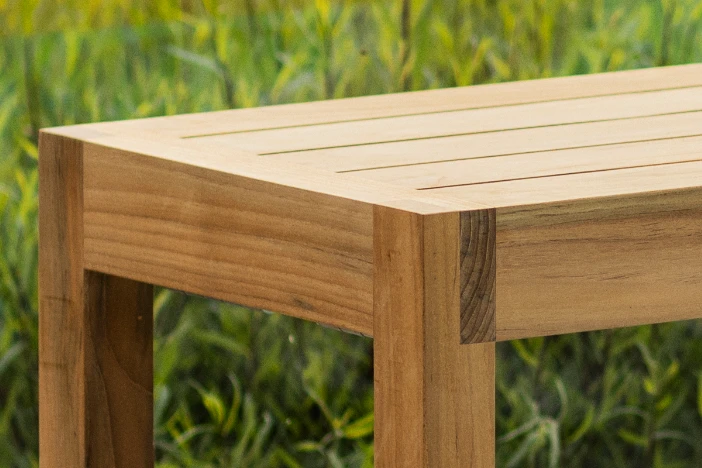
Wooden patio furniture cleaning tips
Wooden outdoor furniture brings warmth and natural beauty to any patio or garden. However, keeping it in top shape requires thoughtful care throughout the year. This guide covers everything you need to know to preserve your wood furniture’s appearance and integrity. It includes seasonal maintenance checklists to climate-specific care tips and advice tailored to different wood types and finishes. Whether you’re dealing with dry desert heat, coastal salt air, or tropical humidity, you’ll find practical strategies to protect your investment and extend its life. Ready to get started? Let’s break down what to do before, during, and after each season to keep your wooden furniture looking its best.

Climate-specific tips for outdoor wood pieces
Different climates place unique demands on wooden outdoor furniture. To keep your pieces looking great and structurally sound, adjust your care routine based on your local environment:
Dry Climates (Arid or High Desert Areas)
- Wood tends to dry out faster in low-humidity regions, leading to cracking and surface “checking.”
- Apply wood oil or sealant more frequently—every few months—to replenish moisture and prevent brittleness.
- Store furniture in shaded areas when possible to reduce UV damage and further drying.
Humid or Tropical Zones
- High moisture levels create ideal conditions for mold, mildew, and fungal growth.
- Use breathable, mold-resistant finishes that allow the wood to expel excess moisture.
- Treat furniture with antifungal or mildew-resistant products as part of regular maintenance.
- Ensure good air circulation around the furniture and avoid placing it directly on wet ground.
Coastal Environments
- Salt-laden air can degrade wood surfaces and corrode metal fasteners.
- Rinse wooden furniture with fresh water occasionally to remove salt residue and prevent buildup.
- Apply protective finishes that offer resistance to both moisture and salt.
- Consider stainless steel or galvanized hardware to prevent rust and staining near the joints.
Tailoring your maintenance strategy to your climate helps preserve the beauty and longevity of your wooden furniture year-round.
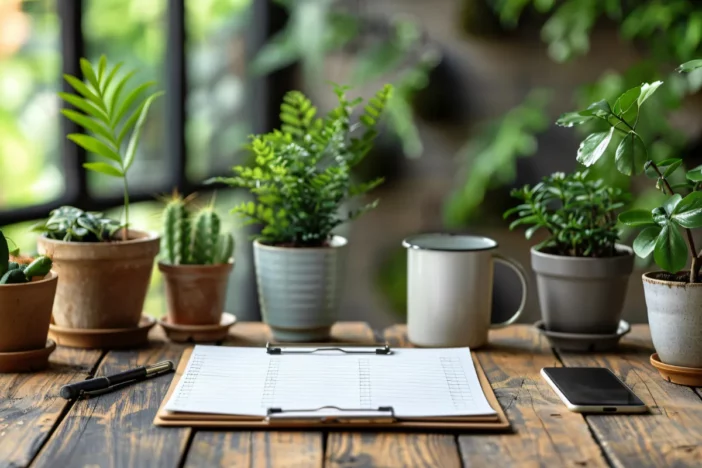
Pre-season checklist for wooden lawn furniture care
Before the outdoor season starts, it’s important to check, clean, and prepare your wooden furniture. This will ensure it is safe, comfortable and looks great. This yearly maintenance helps prevent long-term damage. It also prepares you for a worry-free outdoor season. Here’s a detailed checklist to guide your pre-season care routine:
Pre-Season Prep & Annual Maintenance
- Tighten Joints and Hardware
Inspect all joints, screws, bolts, and brackets. Tighten any loose connections to ensure stability and safety. - Initial Cleaning
Wash surfaces with mild soap and water using a soft brush or cloth. Rinse thoroughly with a garden hose and allow furniture to dry completely. - Inspect for Damage
Look for splinters, cracks, and warping. Pay special attention to areas where water may have pooled or where joints meet. - Re-Oil or Reseal Wood
Depending on the type of wood, apply a new coat of oil, sealant, or finish. This will nourish the wood and protect it from moisture and UV damage. - Check for Mold or Mildew
In humid or shaded areas, clean any mildew with a diluted vinegar solution or a cleaner made for mildew.
Repairing Minor Damage
- Scratches and Dents
For shallow scratches, lightly sand the area with fine-grit sandpaper and reapply oil or finish. Deeper dents may require wood filler or steam-based lifting techniques (if appropriate for your wood type). - Cracks and Splits
Small surface cracks can be filled with exterior-grade wood filler or epoxy. For deeper or structural splits, consult a professional to avoid compromising the piece’s integrity. - Loose Screws and Rusted Hardware
Check all screws, bolts, and hinges. Tighten or replace any rusted or worn parts. Use rust-resistant replacements and apply lubricant (like silicone spray) to moving parts such as recliners or gliders. - Hardware Care
Apply a protective coating or lubricant to metal components to prevent rust and ensure smooth operation. Stainless steel or galvanized hardware is ideal in coastal or wet climates.
Starting the season with a thorough check ensures your furniture stays strong, functional, and beautiful—ready for relaxing, entertaining, and enjoying the outdoors.
General wood cleaning steps
Most wooden garden tables and seating are constructed from hardwoods that can be cleaned and cared for similarly.
- Remove light debris with a soft nylon bristled brush
- Clean the surface using a sponge or damp cloth with mild household soap and warm water
- Soak up any excess water with a microfiber or lint-free cloth
- Allow the wood to dry naturally
If you let the woodgrain patina fade to a lighter color, you can clean your wooden deck furniture once or twice a year. If you want to keep the wood’s natural brown color, clean it regularly. You should also treat it with furniture oil and a light layer of sealant [Jirous-Rajkovic & Miklecic 2018]. The frequency depends on your climate and if the furniture is sheltered. Drier climates or areas with more sun exposure will require more frequent maintenance. Spills should be cleaned immediately to minimize potential staining.
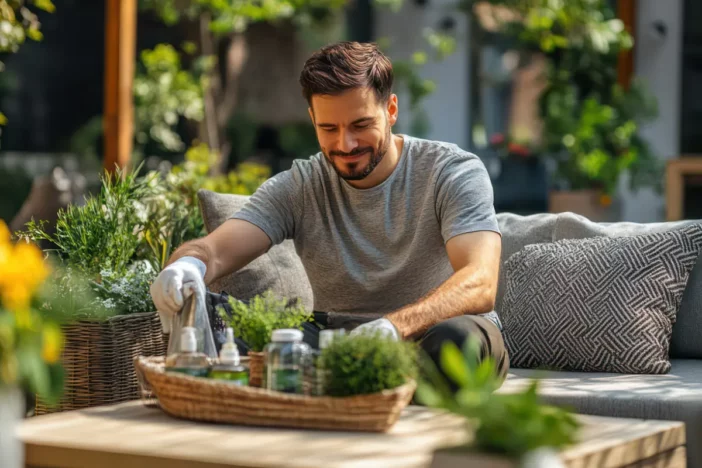
Eco-friendly cleaning & treatment options
Caring for your wooden outdoor furniture doesn’t have to come at the expense of the environment. There are plenty of eco-conscious ways to clean and maintain your pieces without relying on harsh chemicals. For regular cleaning, opt for natural solutions like a mix of white vinegar and water or gentle Castile soap. Both are effective, biodegradable, and safe for use around pets, kids and garden spaces. These options are also greywater-safe, meaning you can rinse them off near plants or lawns without causing harm.
If you prefer store-bought cleaners, choose eco-labeled products. Look for ones that do not have bleach, ammonia, or synthetic fragrances. They should also be marked as biodegradable. When it comes to maintenance, such as re-oiling or sealing your furniture, take care to dispose of old finishes, oil rags, and leftover chemicals properly. Never pour them down drains or toss them in regular trash. Consult your local waste management center for guidance on household hazardous waste disposal. Choosing environmentally responsible practices helps protect your outdoor space and the ecosystems around it.
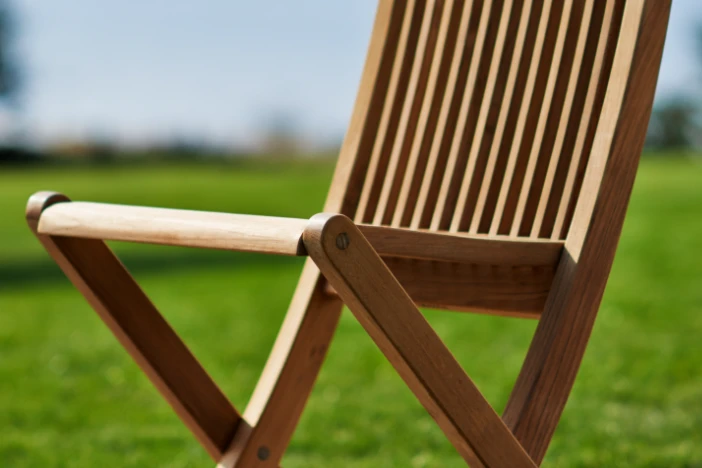
Teak
Teak outdoor furniture can be cleaned using the wood cleaning steps above or a commercial teak cleaner. Some products also brighten the finish so that it more closely resembles its original honey brown color.
Fading to an elegant greyish silver finish
Over time, teak furniture gains a nice silvery gray color. This change is just cosmetic. It does not mean the wood is dry or damaged. Weathered teak has a relaxed style with simple elegance. It is popular in The Hamptons and other upscale coastal areas. Teak’s natural oils help keep this hardwood strong and durable in many environments, so there’s little maintenance. Teak wood is so weather-resistant that it doesn’t need to be stored over the winter or covered with protective tarps.
Keeping your teak’s warm woodgrain look
To retain your teak’s original golden honey finish you can periodically oil the wood. This works well if your furniture is indoors. However, oiled teak can mildew and may change color when outside. You may want to use a protective sealant to keep the teak’s natural color. You can also oil it first for extra protection.
- Give new teak furniture a couple of weeks outdoors
- Clean the wood
- Apply a thin coat of sealer
- Wait one hour before applying a second coat
- Wait an additional 4-5 hours before using the furnishings
Smoothing out the weathered texture of teakwood
The pores of some woods may rise after the first couple of cleanings, creating a roughened texture to the grain. You may need to sand lightly to retain its smooth surface. Additionally, wood will expand and contract over time, so make it a point to check for loose joints each spring and tighten when needed.
Manufacturer video tip – Cleaning your teak
Shorea (a.k.a. Meranti or Balau)
This dense tropical hardwood has a high oil concentration that lessens the chance that it will rot and protects it from insects. Like teak, shorea weathers to an attractive silvery gray color after it’s been outdoors. If you’re okay with that, you only need to lightly clean your wood garden furniture once or twice a year.
Retaining your shorea furnishing’s deep color
To keep shorea wood’s original warm reddish-brown tone, you’ll need to oil the wood every couple of months. As with teak, clean and dry shorea before applying linseed or teak oil or sealer. To be safe, test the oil on a small unnoticeable area. Rub it in with a small paintbrush or soft cloth and allow the surface to dry before seeing if you like the color.
Dealing with mildew & mold on shorea wooden garden furniture
If you live in a warm and damp climate, mold or mildew may grow on your deck chairs and tables. These fungi are not harmful to most hardwoods but could leave unsightly marks and pose health risks to people and pets. Although bleach-based cleaning products are often recommended, some formulations may weaken the wood and leave discolorations.
After a normal cleaning, if your wood furniture still shows signs of mold or mildew, you need to step up your game. Mix a solution with the ingredients below and apply it with a sponge or soft-bristled brush.
- 1 cup of ammonia
- 1/2 cup of white vinegar
- 1/4 cup of baking soda
- 1 gallon of warm to hot water
Any remaining mold that has worked its way into the wood should be sanded out. If that’s the case, use fine-grained sandpaper and refinish or oil the wood afterward.
BUY TEAK OUTDOOR FURNITURE
Eucalyptus (a.k.a. Jarrah)
This hardwood has a lower oil content than teak or shorea and is less water-resistant. Humid environments and places with big temperature changes can make eucalyptus wood expand and contract. This can weaken outdoor patio furniture or deck flooring.
Protect eucalyptus against cracking
The most common problem is cracking. It’s a good idea to oil and seal eucalyptus. Use a polyurethane varnish a few times a year. This will keep the wood strong and protect it from rot and insects. It will also give eucalyptus a rich color and shiny finish. Clean and dry eucalyptus furniture before applying 2-3 coats of protective sealer. Allow each coat to dry for two hours before applying the next.
Be sure to wipe off any standing water after a rainfall to minimize unnecessary moisture contact. If your patio or outdoor area permits keep eucalyptus tables and chairs out of direct sunlight. The UV rays can break down the wood fiber over time and cause discoloration. You can also use a vented protective vinyl cover to help it last longer and stay in top shape.
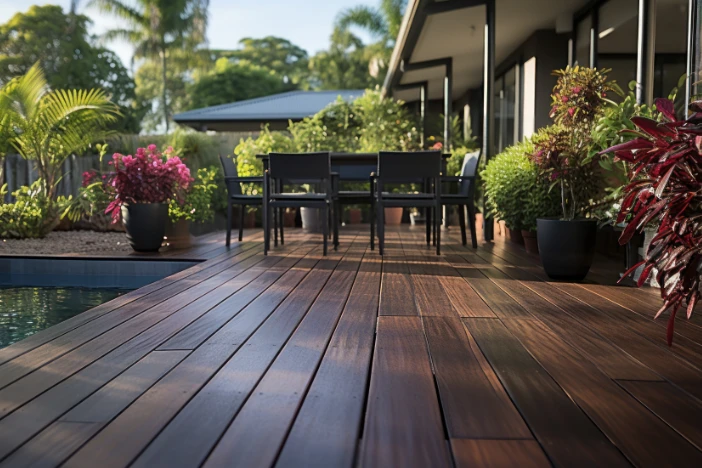
Ipe (a.k.a. Ironwood, Brazilian Walnut & Pao Lope)
This South American hardwood is said to be three times harder than teak. It also has similar weathering traits. If left outside, ipe furniture will mellow from its natural dark brown to pewter gray. Despite the aesthetic color fade, the structural integrity of this long-lasting wood will remain strong over the years. Most of the time, light cleaning will suffice. If tree sap drips on it or mildew forms on the surface, you can clean ipe more thoroughly than other hardwoods. Use a stiff brush, mild soap and water to remove or lessen difficult stains. Rinse all remaining residue off with a hose and let dry.
Maintaining your ipe furniture’s rich coloration
Retain ipe’s naturally dark color by oiling it 3-4 times a year. However, before the initial oiling, you should let your furniture weather for 30-60 days. This makes it easier for the oil to penetrate the dense wood. It may also be necessary to lightly sand the surface to remove minor stains before applying the oil. Do not use varnish or wood sealants on ipe sunroom furniture. The thin layer will quickly flake and peel after you apply it.
Don’t worry if the wood exhibits hairline surface cracks or minor checking. This is an expected result of constant exposure to changing temperatures and the elements.
White Oak
White oak is strong and waterproof. It resists rot well, but it has less oil than other hardwoods used for outdoor furniture. It should be oiled once a year. Use spar varnish or exterior urethane sealant to keep its original light or stained color. Adding oil helps reduce weather checking. This happens when wood is exposed to the elements for a long time. Over time, without sealant, white oak will turn dark brown or even black. However, it may be a good idea to let new furniture weather for a season or two before applying one. Instead of a clear coat that allows the natural wood grain to show through, you can also paint it white.
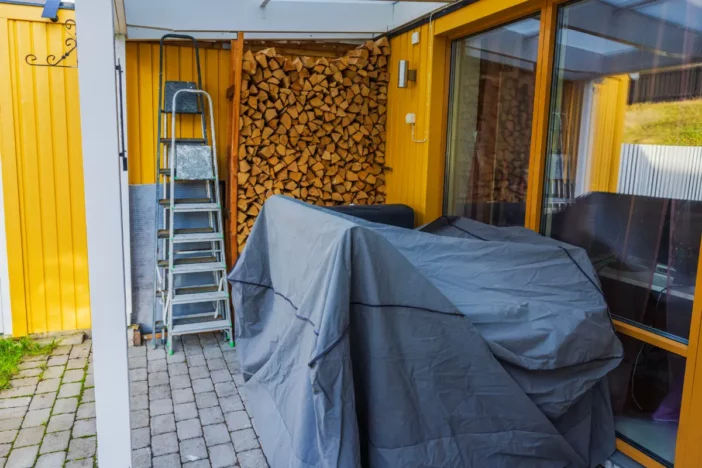
Off-Season Care Tips for Wooden Outdoor Furniture
When the outdoor season winds down, it’s important to take proper steps to protect your wooden furniture during the off-season. This is especially true through wet or freezing winter months. Some hardwoods, like teak and ipe, resist weather well. However, all wood types need careful cleaning, storage, and protection. These off-season care tips help prevent mold, cracking, and unnecessary wear, so your furniture is ready to shine come spring.
Clean Thoroughly Before Storage
- Always clean wooden furniture before putting it away for the season.
- Use a mild soap solution and a soft-bristle brush or cloth to remove dirt, pollen, and any organic debris.
- Rinse thoroughly and allow pieces to dry completely to prevent mold, mildew, and rot during storage.
Choose the Right Storage Location
- Store furniture in a cool, dry, and well-ventilated area—such as a garage, basement, or storage shed.
- Stay away from places with high humidity, direct sunlight, or big temperature changes. These can make wood warp, crack, or fade.
Use Proper Covers for Protection
- If you store your furniture outside or in semi-covered areas, use breathable covers. Choose covers made of polyester or canvas with vents.
- Avoid plastic tarps or non-ventilated covers that trap moisture and encourage mold growth.
- Ensure covers are well-fitted but allow some airflow to keep wood dry and stable.
Elevate Off the Ground
- Don’t store wooden furniture directly on concrete or bare ground, as it can absorb moisture and cause swelling or decay.
- Use pallets, bricks, or wooden blocks to raise pieces slightly off the ground, allowing airflow underneath and keeping moisture at bay.
Cleaning and storing your wooden furniture properly during the off-season will extend its life and preserve its finish. It will also minimize the work required to bring it back into use when warm weather returns.
Helpful Article
We suggest checking the woods section of our Outdoor Furniture Materials Guide. It shows the pros and cons of different woods.
Woods are just one common material
Teak, shorea, eucalyptus, ipe and white oak are woods frequently used for outdoor furniture but there are other materials. The next section of our guide outlines several of the metals utilized for frames.
Guide Sections
References
- Jirous-Rajkovic, V., & Miklecic, J. (2018). Weathering Resistance of Modified Wood-A Review.

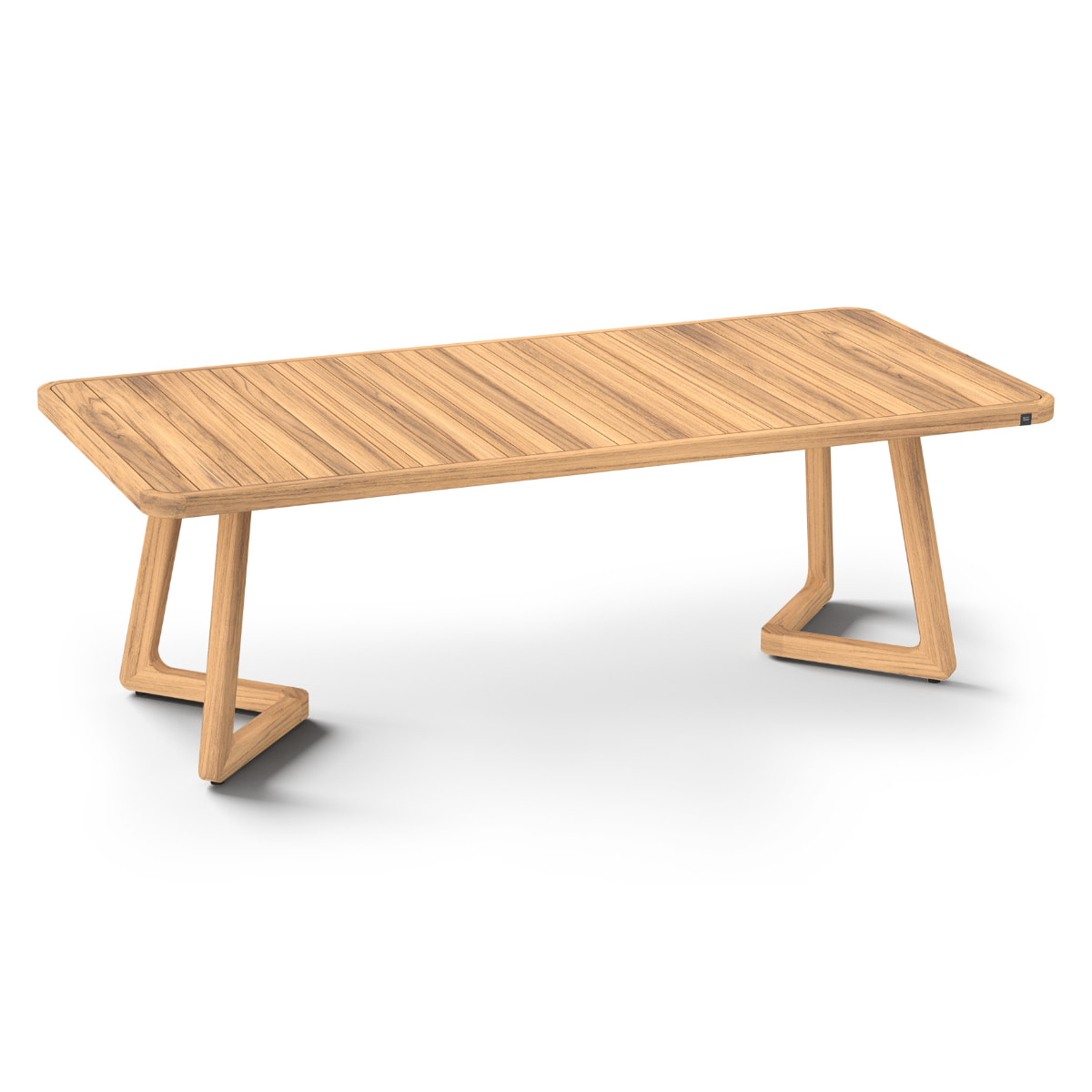
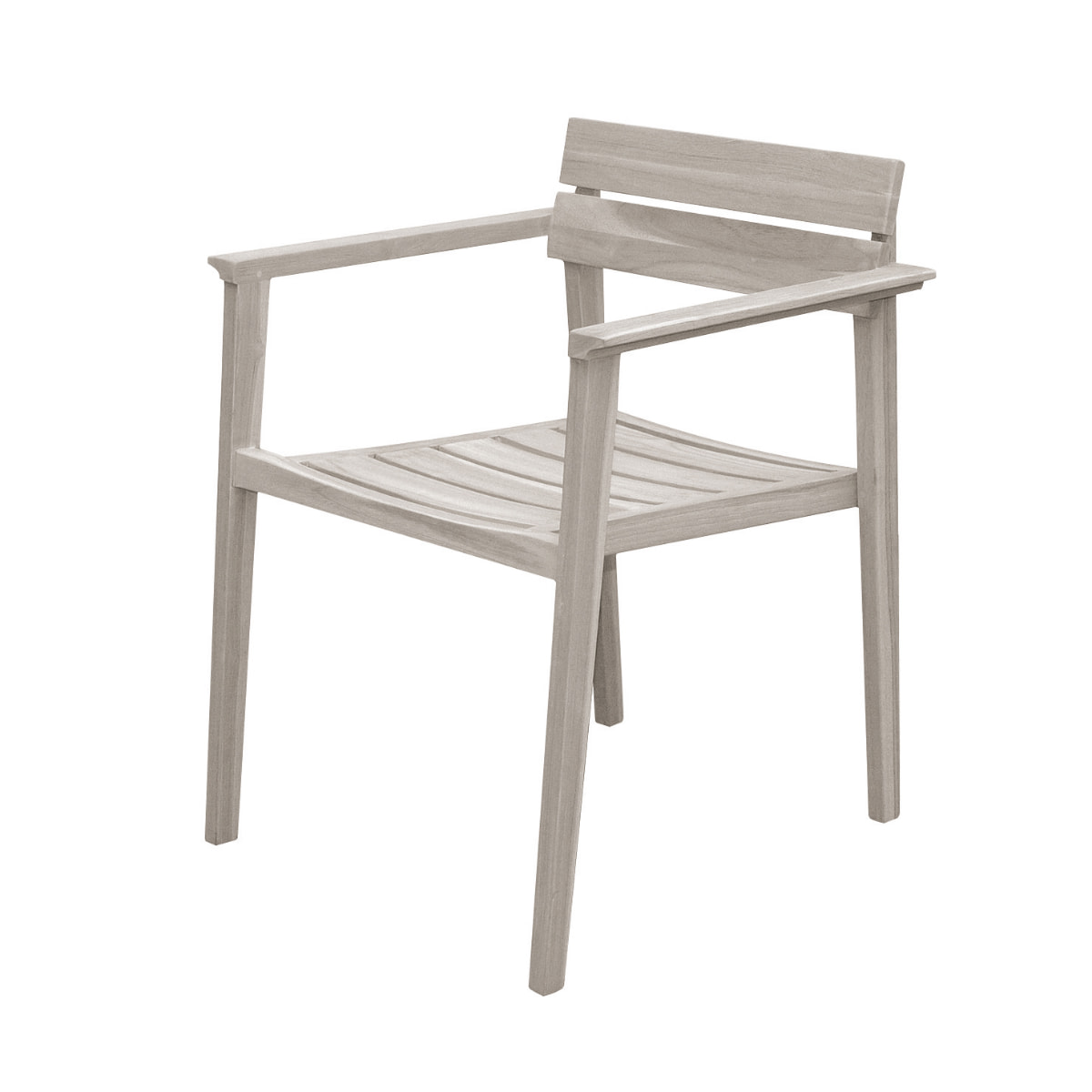
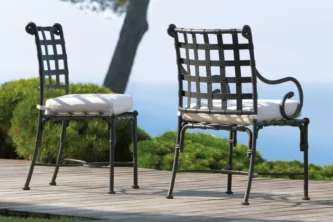
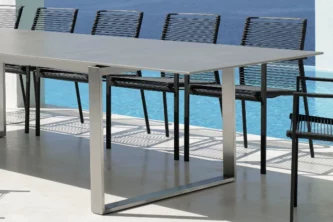
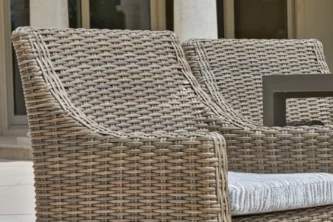
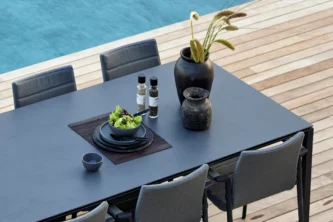
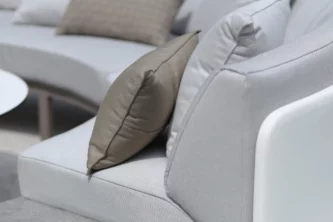





Leave a Reply